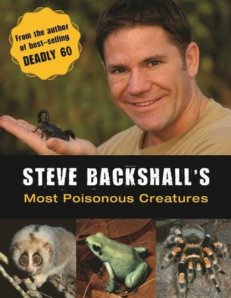 Steve Backshall’s Most Poisonous Creatures, Steve Backshall (New Holland 2013)
Steve Backshall’s Most Poisonous Creatures, Steve Backshall (New Holland 2013)
As the BBC naturalist Steve Backshall says in his introduction: “Human beings have an unhealthy obsession with any animal that can maim or mutilate, and those that deliver venom are obviously high on our fascination list.” But is it unhealthy? It’s wise to pay attention to dangerous things and it’s possible that some animals in this book have become part of our DNA. Human beings were once monkeys and monkeys have an instinctive fear of snakes (though it needs to be primed). If there’s an instinctive fear of snakes, why not of spiders and scorpions too?
There are lots of snakes in this book, but not so many spiders and few scorpions. The latter two are a more specialized taste and a popular book doesn’t want too many of them. Snakes often inspire respect, spiders and scorpions often inspire repulsion. As do centipedes and cane-toads. Some venomous animals look villainous, some poisonous ones look painful. Some don’t. Phyllobates terribilis is “believed to have enough poison to kill ten men”. But it’s a harmless-looking golden frog shown here perched on a scarlet flower (pg. 10). If you saw one, you’d feel like picking it up. Which would be a very bad idea.
That also applies to the two species of blue-ringed octopus, Hapalochlaena lunulata and H. maculosa, found around the Australian coast. Again, it’s a very bad idea to pick one up: “one tiny, golf-ball-sized octopus can have enough venom to kill 26 people” (pg. 115). That combination of delicacy and deadliness gives a special power to the poison-dart frogs and the blue-ringed octopus. Australia’s deadliest snake is more conventionally disturbing:
The most powerful venom, drop for drop, is produced by the inland Taipan (Oxyuranus microlepidatus): a single drop from this beautiful snake is enough to kill 250,000 mice and by extrapolation, 100 people! However, no-one has ever been killed by one. This is mainly because they are shy snakes that tend to avoid human contact. (pg. 120)
Australia is famous for strange and dangerous wildlife, but its cars are much deadlier than its snakes or octopuses. Less dangerous, but even stranger is the duckbilled platypus, Ornithorhyncus anatinus. Very few mammals lay eggs and very few use venom. The platypus does both, though not at the same time: the females lay eggs and the males use venom, injecting it with “moveable spurs on the rear legs” (pg. 118). One Vietnam veteran who experienced a platypus sting said it was more painful than a bullet-wound.
But there’s even more toxicological strangeness in that part of the world: Papua New Guinea has at least one poisonous bird, Pitohui dichrous, the hooded pitohui. It uses the batracho-toxins first discovered in, and named for, the poison-dart frogs of South America, just as the blue-ringed octopus uses the tetrodotoxin first discovered in, and named for, the pufferfish, Tetraodontidae spp. All these groups get their deadly chemicals from their diet: insects, plankton and so on.
So why don’t they die from their diet? That’s one of the interesting questions about the animals in this book: their venoms and poisons have to be dangerous to others and harmless to themselves. It’s a question of chemistry, one way or another. Either the animal has a way of neutralizing the effects of its own poisons or it stores them away from the rest of its body, creating some kind of barrier to their spread. Richard Dawkins has described evolution as a blind watchmaker, but the watchmaker is really a chemist. And an electro-chemist. Nerve-signals, and the toxins that interfere with them, don’t run on copper wires. They flash through flesh instead, carrying the pain of a bite or sting. Or the patterns of a dangerous animal’s skin or scales: it pays to advertise when you’re poisonous. And perhaps some feathers are advertising too: Backshall suggests the birds of paradise on New Guinea may look spectacular as a warning for predators, not simply as a signal for mates.
Poisonous birds are a recent discovery and there may be more surprises in store: biology is a big field, though Backshall ends the book by noting that it’s getting smaller. More people mean less space for fewer animals and pollution is the deadliest poison of all. Another big poison is television: it dulls more brains and stifles more minds than anything Mother Nature ever devised. But this book wouldn’t exist without TV and Homo sapiens is part of nature, just like shrews, salamanders and slow lorises. We’ve just added more complexity to the game of evolution: we haven’t escaped it. The rules that apply to animals also apply to us and toxicology is one of the most interesting areas of biology. This is a good introduction full of photos, folklore and facts about everything from snakes, octopuses and platypuses to jellyfish, water-boatmen and the Komodo dragon.